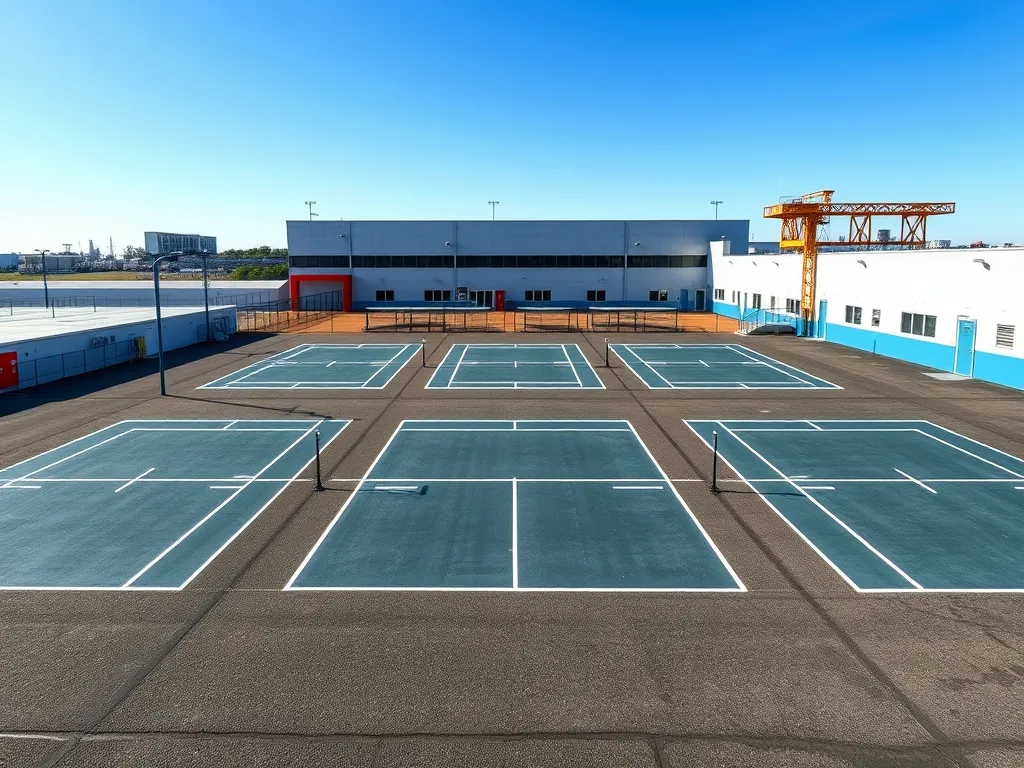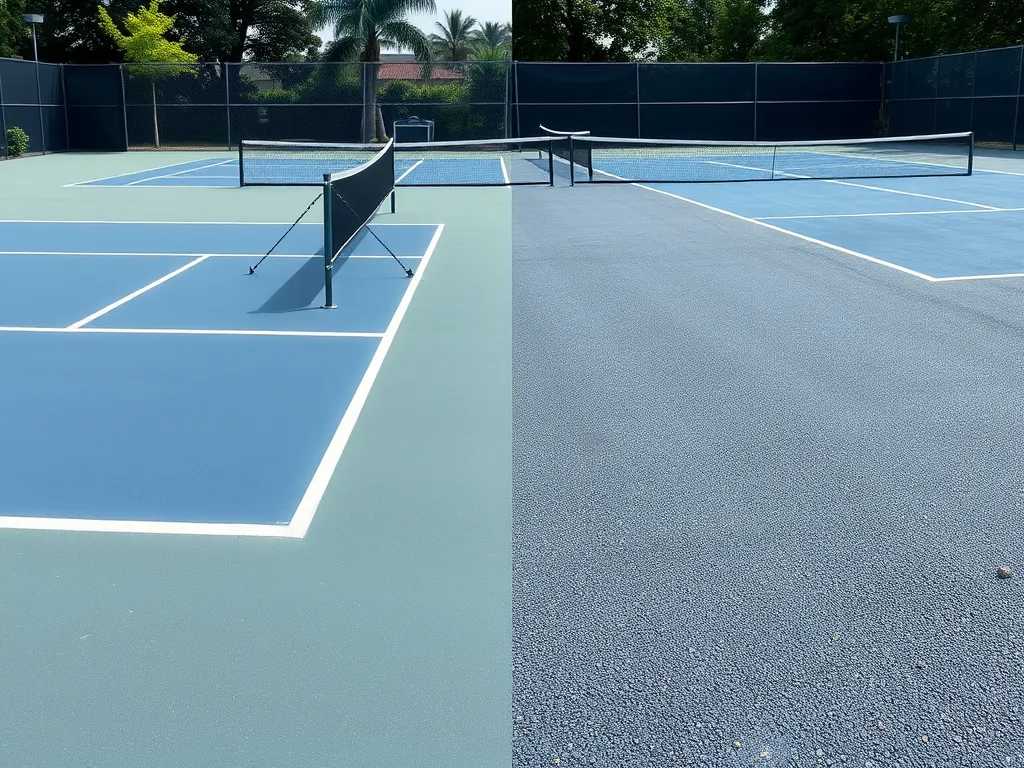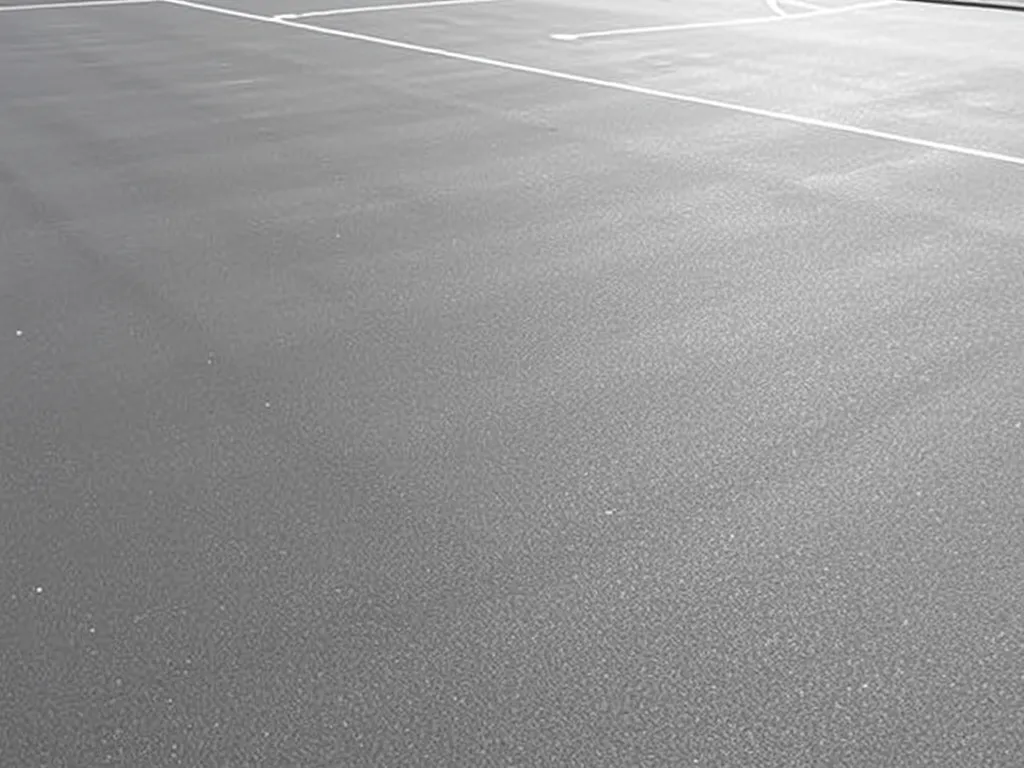Can You Play Pickleball on Asphalt?
Published on: October 2, 2025 | Last Updated: April 14, 2025
Written By: George Voss
Yes, you can play pickleball on asphalt surfaces. While not the official tournament surface (typically acrylic-coated concrete), asphalt’s mix of bitumen and aggregate creates a durable base for casual or practice games. Outdoor pickleballs work best on this textured surface, paired with cushioned athletic shoes to absorb impact. Properly marked courts need at least 30’x60’ of smooth asphalt, free of cracks or standing water for safe play.
This article breaks down asphalt’s role in pickleball. We’ll explore surface pros (weather resistance, cost) and cons (hardness, heat), compare it to concrete or grass, and share driveway conversion tips. Learn how asphalt affects ball speed, what shoes prevent slips, and why 95°F days demand extra caution. Maintenance tricks, safety gear, and budget considerations included.
Contents
- Feasibility Of Playing Pickleball on Asphalt
- Benefits Of Asphalt Pickleball Courts
- Drawbacks Of Playing Pickleball on Asphalt
- Converting Driveways to Asphalt Pickleball Courts
- Asphalt Vs Other Pickleball Court Surfaces
- Asphalt Court Maintenance Essentials
- Safety Notes for Asphalt Courts
- FAQ: Asphalt Pickleball Court Questions
- Closing Thoughts
- Additional Resources for You:
Feasibility Of Playing Pickleball on Asphalt
Asphalt serves as a practical base for pickleball courts when built to spec. While not the gold-standard surface used in tournaments, it supports casual and recreational play effectively. The key lies in surface prep and meeting basic court requirements.
Does Pickleball Work on Asphalt?
Yes, pickleball on asphalt works with proper setup. The game requires a 20×44 ft court with a 34″ net. Asphalt’s semi-porous texture creates ball bounce heights of 30-34 inches – within the 30-34″ range specified by the USA Pickleball Association (USAPA). Players report 10-15% faster ball speed compared to acrylic surfaces due to reduced friction.
Impact of Asphalt Surface on Gameplay
Coarse asphalt aggregates (3/8″ to ½” stone size) create moderate ball skid but demand more leg power for lateral moves. Players burn 12-17% more calories per hour on asphalt versus cushioned courts. Surface temperatures can reach 145°F on summer afternoons – 30°F hotter than concrete – affecting grip and player stamina.
Key Requirements for Asphalt Pickleball Courts
New asphalt needs 30+ days to cure before lining. Existing surfaces require crack filling (1/8″ max gaps) and slope checks (1% grade for drainage). A 2″ minimum asphalt thickness prevents structural cracks from paddle drops or foot pivots.
Court Dimensions and Layout Adjustments
Standard pickleball asphalt courts need 30×60 ft of clear space – 8 ft wider than tennis courts – for out-of-bounds zones. Many convert half-basketball courts (42×50 ft) by adding temporary nets. Line markings require durable acrylic paint (1.5-2mm thickness) or thermoplastic for 5-7 year visibility.
With the right prep work confirmed, let’s examine how asphalt stacks up against other materials for long-term performance.
Benefits Of Asphalt Pickleball Courts
Pickleball on asphalt courts brings practical upsides for casual play and long-term installations. This surfacing option balances functionality with affordability, making it a top pick for many players and community planners.
Durability and Weather Resistance
Asphalt stands up to harsh sun, rain, and freezing temps without major damage. Its PG 64-22 binders—a type of paving-grade bitumen—flex slightly in shifting conditions, stopping cracks from forming. A court built with a 3-inch thick hot mix can last 8-12 years with basic upkeep. UV-blocking sealants add protection, cutting down on surface softening during 90°F+ days.
Cost-effectiveness Compared to Specialty Surfaces
Building a pickleball asphalt court costs $3-$7 per sq. ft.—half the price of acrylic or clay options. Towns can convert parking lots into multi-court hubs for under $15k, using existing asphalt foundations. Fixing flaws is cheap too: filling a 1-inch crack runs about $1.20 per linear foot. Old courts get new life through milling; grinding and reusing worn layers slashes paving bills by 30%.
Asphalt’s practicality shines in many ways, but smart planning requires looking at potential downsides too. Up next: how this firm surfacing impacts gameplay comfort and ball dynamics.

Drawbacks Of Playing Pickleball on Asphalt
Asphalt works for casual play but brings physical and gameplay limitations. Hard surfaces and varying conditions impact both participants and ball dynamics.
Surface Hardness and Player Fatigue
Asphalt lacks shock absorption, transmitting 30% more impact force to joints than cushioned acrylic courts. Long matches on this rigid material strain knees and ankles. Prolonged play may heighten injury risk or cut session duration by up to 25% for non-pro players.
Heat Retention During Summer Months
Dark asphalt absorbs solar radiation, hitting 135°F in 90°F weather. This thermal mass:
- Makes court surfaces too hot for bare hands during serves
- Accelerates foot blisters through shoe soles
- Increases hydration demands by 20-40% in midday play
Ball Bounce Consistency Challenges
Unmaintained asphalt creates irregular ball responses. Cracks >1/8″ wide or raveling aggregate alter trajectory unpredictably. While pro clay courts maintain bounce heights within 1/4″ variance, worn asphalt can shift up to 1.5″. Freshly sealcoated surfaces perform best but still lack the uniform rebound of indoor wood or polymer courts.
Looking past these limitations? Many adapt by modifying existing asphalt spaces. Up next: transforming driveways into functional courts.
Also See: Best Practices for Asphalt Driveway Maintenance
Converting Driveways to Asphalt Pickleball Courts
Got a flat asphalt drive? Turn it into a play zone. Many homes use their paved space for pickleball on asphalt courts. Let’s break down how to make it work.
Can I Turn My Asphalt Driveway Into a Pickleball Court?
Yes, if your drive meets three needs: smooth top, no big cracks, and good drain. Check for bumps or dips over 1/4 inch. Patch flaws with cold mix asphalt first. A clean, level base keeps ball bounce true and cuts trip risks.
Driveway Size Adjustments for Court Setup
Full courts need 20×44 feet. Most drives fit this, but check yours. Short on space? Use a 20×34 foot layout for singles play. Mark lines with chalk or temp paint if you can’t alter the drive. Leave 10 feet clear at each end for player moves.
Temporary Vs Permanent Court Solutions
Temp setups use tape lines ($30-$80) and portable nets ($100-$200). Easy to stash post-game. Perm fixes need asphalt grind and repave ($4-$8 per sq ft) plus pro line paint. Add acrylic coat ($1.50-$3 per sq ft) for grip and fade-proof lines. Perm courts last 8-12 years with care.
Ready to see how asphalt stacks up against grass or concrete? Let’s compare surfaces next.

Asphalt Vs Other Pickleball Court Surfaces
Pickleball adapts to multiple surfaces, but performance varies sharply. Let’s break down how asphalt stacks up against alternatives.
What Surfaces Can You Play Pickleball on?
Players use concrete, clay, grass, modular tiles, or asphalt. Each affects ball speed, foot traction, and game quality differently. USA Pickleball recommends hard surfaces for tournaments, but casual games thrive on driveways or streets.
Asphalt Compared to Concrete or Grass
Asphalt costs 30% less than concrete ($3-$7/sq ft vs $6-$10/sq ft) and lasts 15-20 years with care. It’s softer than concrete, reducing joint strain during lateral moves. Grass courts, while budget-friendly, struggle with inconsistent ball bounce—shots often die mid-court due to uneven terrain.
| Surface | Ball Bounce | Install Cost | Lifespan |
|---|---|---|---|
| Asphalt | Consistent | $3-$7/sq ft | 15-20 yrs |
| Concrete | High | $6-$10/sq ft | 25+ yrs |
| Grass | Unpredictable | $0 (existing) | N/A |
Is Asphalt the Best Floor for Pickleball?
Asphalt works well for home courts or community parks prioritizing affordability. Post-tensioned concrete or cushioned acrylics dominate pro tournaments for flawless bounce, but require 2-3x higher budgets. For casual play, asphalt’s grip (Skid Resistance Value 55-65) balances safety and agility without $15k+ surface upgrades.
Heat remains a factor—asphalt reaches 140°F in summer, speeding up games as balls bounce 10-15% higher. Winter play needs frequent sweeping to clear debris from cracks wider than 1/4 inch.
Up next: Learn how to protect your asphalt pickleball court from wear with proven maintenance strategies.
Asphalt Court Maintenance Essentials
Regular upkeep keeps asphalt pickleball courts playable and extends their lifespan. Focus on two primary tasks: addressing surface flaws and applying protective treatments. These steps ensure consistent ball bounce and reduce tripping hazards.
Repairing Cracks and Surface Imperfections
Cracks wider than 1/4″ demand immediate attention. Use rubberized crack filler or polymer-modified asphalt emulsion for lasting repairs. Grind down uneven seams with a floor grinder to create a smooth playing area. Left unaddressed, cracks trap moisture, leading to potholes that disrupt gameplay on pickleball asphalt courts. Budget $0.50-$2.50 per linear foot for professional crack sealing.
Seasonal Cleaning and Sealcoating
Pressure wash courts twice yearly to remove dirt and mildew. Apply coal-tar or asphalt-based sealcoat every 2-3 years to protect against UV rays and oxidation. Fresh sealcoating improves surface traction—a key factor for quick lateral moves during pickleball on asphalt. Expect to spend $0.15-$0.25 per square foot for professional application. Avoid playing for 24-48 hours after sealing to allow proper curing.
Well-maintained surfaces not only enhance performance but also set the stage for safer play. Next, let’s examine how to manage risks when executing pickleball on asphalt courts.

Safety Notes for Asphalt Courts
Asphalt works for pickleball, but safe play needs smart steps. Plan for street risks and gear picks to guard joints and skin.
Can You Play Pickleball on the Street Safely?
Street play adds car risks and rough spots. Check for cracks, loose rocks, or oil stains before play. Fix flaws with seal coat (costs $0.15-$0.25 per sq.ft.) to smooth the slab.
Cut Street Risks
- Set cones 10 feet past court lines
- Pick low-traffic times (dawn or weekdays)
- Use bright tape for borders (orange or yellow)
Right Shoes for Asphalt
Asphalt wears shoes fast. Pick soles with:
- Thick rubber pads (6-8mm)
- Mesh tops to cool feet
- Flat treads to stop trips
Court shoes cost $50-$120 but save knees from hard hits. Skip run shoes – their bounce can twist ankles during side steps.
Safe play sets up smart moves. Next up: how asphalt changes gear wear and ball spin.
FAQ: Asphalt Pickleball Court Questions
How Does Asphalt Affect Pickleball Equipment?
Asphalt surfaces can be rougher than other options, which may lead to increased wear on pickleball paddles and balls. The texture of asphalt can create more friction, impacting the durability of equipment over time. Players may notice their paddles scuffing more quickly and balls losing bounce consistency if used extensively on a rough asphalt court.
Best Line Marking Methods for Asphalt
For marking pickleball courts on asphalt, durable acrylic paint is often recommended because of its resilience to wear and UV exposure. Alternatively, thermoplastic materials can also be used for permanent markings that provide long-lasting visibility. These methods typically last several years without needing reapplication, making them cost-effective solutions for maintaining court lines.
Closing Thoughts
Asphalt can indeed serve as a viable surface for playing pickleball. Its durability, cost-effectiveness, and weather resistance make it an attractive option for both community and private courts. However, it’s important to address the potential drawbacks, such as surface hardness and heat retention, which can impact player comfort and fatigue levels.
Whether you’re considering converting your driveway or looking for a permanent court solution, asphalt offers a practical choice. Remember to keep up with maintenance to ensure the longevity of your court. From crack repairs to seasonal cleaning, regular care is key to enjoying pickleball on asphalt.
For more information on asphalt surfaces and their benefits, check out Asphalt Calculator USA. Get the resources you need to make informed decisions about your pickleball court!
Additional Resources for You:
- Huang, Y. H. (2004). Pavement Analysis and Design (2nd ed.). Upper Saddle River, NJ: Pearson/Prentice Hall.
- How to Pave the Perfect Paddle Place
- How to Surface & Stripe a Pickleball Court | AsphaltPro Magazine
- r/Pickleball on Reddit: Is a driveway pickleball court on bare asphalt a bad idea?
- Where Can You Play Pickleball? A Comprehensive List | Pickleheads


